By Robert Lopez-Hanshaw
composer and musical director
Why would anyone expect a choir to be able to sing microtones? All of the literature seems to be about their limitations.[1] Everyone knows that choirs are devastatingly conservative, anyway. They, and their audiences, would surely revolt at the slightest hint of strangeness. There are some who celebrate[2] this paradigm, saying that the limitations of the massed human voice have constrained choral music to a more traditional style in the face of modernity, and that it’s a good thing they have!
This obviously rules out microtonal music of any sort. That stuff is pretty weird.
But—of course—there are cracks in this theory. Looking beyond the Western choral paradigm, the world is overflowing with examples of formidable vocal control. There are Indian, Turkish, and Arabic singers, for whom very tiny intervals are a fundamental part of music, without which the very identity of a given melody would be compromised. The Egyptian singer Umm Kulthum, in particular, was not just an adept practitioner of these microtonal gradations in interval quality; she was the authority on proper intonation.[3]
And even within the Western music scene, there exists the idea of Just Intonation: the pure arithmetical tuning of chords, as distinct from our modern 12-tone, logarithmic tuning. This has slowly worked its way into general choral consciousness over the last century or two, having been abandoned only relatively recently, post-Renaissance.
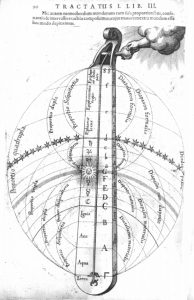
But, as many who have professionally recorded themselves singing can attest, the limitations of human pitch control are something to contend with. These limits are humiliatingly displayed by taking a look at what you thought was a pretty decent take, using pitch analysis software like Melodyne. Was I really that many cents off?
Composers may sigh and shake their heads, thinking: “Sure, microtonal singing is possible. But unless I’m commissioned by Exaudi or Neue Vocalsolisten Stuttgart or Roomful of Teeth, it’s not going to happen if I call for it!”
Spoiler alert: It can. I am a choral composer and conductor, and I am also a microtonalist. I’ve recently had some success with microtonal pedagogy for choirs, which will be the specific topic of the sequel to this article. After that, my piece vokas animo, for choir and orchestra in 72 tones per octave, will have a performance excerpt posted on YouTube and in the NewMusicBox blog.
How could such a thing occur? My case might be especially unlikely. Until relatively recently, I had no exposure to ensembles like those listed above; small, professional vocal ensembles who routinely play around with extremely tiny intervals. I grew up in Tucson, Arizona, and never left. It’s a choir town, fed by the excellent and internationally-recognised Choral Conducting graduate programme at the University of Arizona, but it’s not exactly a hotbed of new music.
So, this first article is about how I found microtonality—or how it found me—through collisions with writers and aspects of culture that are not, by and large, much associated with new music. It’s about how microtonal thinking influenced the music I made, and how that process came to impact the way that I now teach it to choirs. To normal singers.
Because, if I can learn it, why can’t they?
BEGINNINGS: REJECTING TONALITY
I came to music later than many of my colleagues. Before the age of 11, I didn’t even listen to it much. But by 14, I had picked up a guitar and learnt some rock and flamenco songs from guitar tabs. At 16, I had learnt how to actually read music, and then worked through a second-hand harmony textbook while my friend was taking a music theory class. So I remember my struggles with the basics very clearly, and the triumphs as well. I can still taste the deliciousness of finding out about augmented 6th chords, like forbidden fruit! More fundamentally, I remember the visceral feeling when, in about the 7th grade, my choir teacher first demonstrated a major chord in contrast with a minor one on the piano. The difference was so powerful, yet so subtle! I couldn’t figure out what was changing.
Learning how these things were put together was electrifying. So, given this background—with music still in its honeymoon phase, still bright and new—came my first introduction to microtones.
When I was about 16 or 17, a hyperlink on some forgotten website took me to www.anti-theory.com; a manifesto written by Q. Reed Ghazala, about something called “circuit-bending”. He described how he would painstakingly, semi-randomly alter the guts of electronic toys so they produced new and powerful noises. I ended up on a page describing an object called the “Deep Photon Bassoon”, over which a player would wave their hand and produce theremin-like glissandos. But also, using the other hand, a player could do something which sounded insane to me: cause the pitches to settle into steps, but in “arbitrary scale divisions” (the number of pitches that can occur between octaves).
This was the new coolest thing I had ever heard.
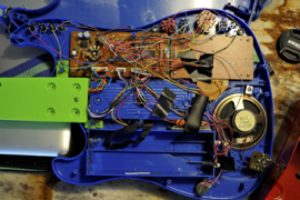
Back then, there was no YouTube quite yet. So, aside from the occasionally terrifying sound clips on Ghazala’s website, I only came across one other example of this during that period of my life. This was the guitar solo in The Doors’ “When The Music’s Over”. (The part in question starts a little after 2:50 on the track, found on the 1967 album Strange Days).
It sounded absolutely unmoored from everything around it, like the guitarist was using a slide without regard for fret positions. I thought, “That’s it, that’s what arbitrary scale divisions sound like!”
Fifteen years later, it turns out that he didn’t use a slide. And it’s not really in “arbitrary scale divisions”, it just has plenty of microtonal bends. Still, the heavily chromatic and semi-aleatoric non-melodies, the oft-warped pitch, the ametrical rhythms and the bizarre, alien timbre had combined to create a passage that divorces itself emphatically from the music that surrounds it.
Coming back to the specific case of microtonal choral music, we can directly compare the use of microtones in this solo—and the resulting polyphonic texture—to the first movement of Giacinto Scelsi’s 1958 compositon Tre Canti Sacri, especially during the second minute of the movement. Neue Vocalsolisten Stuttgart have recorded this, and their performance is available on Youtube.[4]
This is a piece in which gestures are king, comprising superseding melodies, and in which intervals are arguably used for their timbre; ranging in dissonance from pure unisons and 5ths, all the way to fast-beating quarter tones. The atmosphere is tense and alien—a favourite atmosphere in 20th century art music. And, though Scelsi’s piece is tightly focused in contrast to Robby Krieger’s freewheeling solo(s), microtonality was used as a tool to achieve the same effect in each: to exit the tonal hierarchy, to momentarily free the listener from those associations.
This sort of thing may make a choir director nervous.
After all, tonal hierarchies are half of what singers use to even produce pitches at all, not having any keys in our throats. But it needn’t be a non-starter. First, there are rational ways to approach a piece like this, using what is familiar in the music as a support structure. And second, music that uses microtonality specifically to reject familiar structures rarely requires precise intonation to succeed.
In the Scelsi, much of the time, I would say that an error of even 30c or so in either direction—unacceptable in tonal contexts—would still convey the necessary information. (For a fascinating case study of this sort of thing in instrumental microtonal music, see Knipper and Kreutz, Exploring Microtonal Performance of ‘…Plainte…’ by Klaus Huber, 2013).
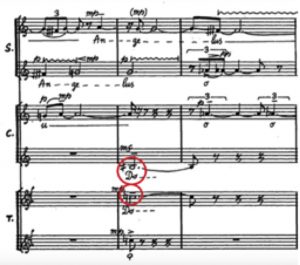
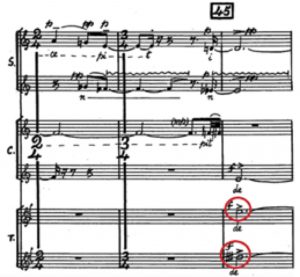
Even in this excellent recording, we do hear such variation. For example, the quarter-tonal diad between Tenor 1’s B ¼-sharp and Contralto 2’s C natural in measure 17 (about 0:38 in the video) is virtually a unison, whereas the one in measure 45 (1:39) between Tenor 1’s E natural and Tenor 2’s D ¾-sharp is much wider, even approaching a semitone. Nevertheless, I am confident that few would accuse Neue Vocalsolisten of doing damage to Scelsi’s piece!
THE OTHER SIDE OF THE COIN: EXPANDING TONALITY
We return to a time before I had heard of Scelsi. I was just beginning to really study composition, and fortuitously stumbled across a book while house sitting for a family friend. This was Ernst Toch’s The Shaping Forces In Music. Published in 1948, the book is an engrossing (and largely ignored) attempt to find commonality of practice between tonality and atonality. But one section, only a few pages long, stood out. In this, Toch advocated microtonality as potentially compatible with all musical approaches. He even discussed how it might have provided a neat solution to a “problem” that Beethoven, of all people, ran into.

In Toch’s words, “Around the advent of [bar 8]… [the] smooth rhythmical flow of the bass is balked for three beats, there being no more moving space left for the descending voice. …[T]he problem could be solved by the use of quarter-tones as shown”. Here is one of his potential solutions (he also changed the inner voices for clarity’s sake):
And he suggested singing it as a practical means to experiencing it. “It is recommended that the quarter-tone passage of the bass be sung, while playing the rest of the voices on the piano. One will be surprised at the facility of the task, its novelty being sufficiently eased by its tangible logic”. For me, this was one of those quotes that stuck. I took Toch’s advice, later, writing unobtrusive microtonal basslines and vocal harmonies, whenever a particular tonal problem spot seemed to require a microtonal solution.
Shortly after coming across Toch, I went to a choral conference and someone mentioned Just Intonation for choirs as a tuning strategy for conventional music. It seemed arcane and I forgot all the cents’ offset values, though it was interesting.
I also took a strange class on building instruments out of scrap metal, for which the textbook was Musical Instrument Design by Bart Hopkin. (An excellent book on “outsider” approaches). This book discusses Just Intonation a bit and, most importantly for me, it has a tuning chart in the back. This compares 12-tone equal temperament with several other systems, both JI and different equal divisions of the octave. Harry Partch’s collection of 43 tones was included. I was amazed at the sheer variety of intervals that apparently made some kind of harmonic sense. (I didn’t actually hear his music until years later).
With all of this kicking around in my head, I started playing in a rock band and we recorded an album. One particular take on the guitar had incredible timbre, but it also had an error, so we had to redo it. But I couldn’t recreate the timbre! After extended frustration and tinkering, we discovered that the guitar on the first take had been slightly knocked out of tune; so the major third had been flatter than usual. After I had routinely re-tuned it for the overdub, that property was erased. So, remembering the Hopkin book, I tried tuning the offending string to the 5th harmonic; lo and behold, there was that timbre again! A weirdly resonant and supported sound for a major triad on an overdriven guitar. I thought, “So that’s what Just Intonation does”.
Later, dense vocal harmony became part of the aforementioned rock band’s schtick, but we struggled to stay in tune in live situations. So, with the guitar experience in mind, I looked for some kind of reference to use to help us out. That turned out to be W. A. Mathieu’s Harmonic Experience, a manual for understanding Just Intonation in practice (and applying it to jazz harmony). The band didn’t end up using any of the exercises—more’s the pity!—but the book showed me how it may be necessary to shift sustained tones by tiny intervals, “commas”, in order to maintain pure tuning as the underlying harmony changed. But, more importantly for Mathieu, it discussed the bodily feeling of pure tuning. That’s the way to learn these new/old intervals.
And old they are. Nicolà Vicentino wrote pieces which encapsulate parts of both Mathieu’s and Toch’s thinking, in the year 1555. The avant-garde vocal chamber group Exaudi has released pioneering a capella recordings of Vicentino’s microtonal experiments, which are available on YouTube; a highlight is Dolce mio ben.[5]
This has both Just Intonation-esque aspects—very narrow major 3rds and very wide minor 3rds—and quartertonal-esque aspects, which resemble Toch’s insertion of intervening microtones in an otherwise chromatic line. In the middle of what we would now call a V-I progression in G, Vicentino places an “extra” leading tone between the F# and the G. Unlike Toch, he tunes a whole chord to this intervening tone. This happens at 0:18 in the YouTube video I referenced. See the score excerpt below (lyrics simplified).

It’s not truly quartertonal, nor truly Just Intonation. It’s really in 31-tone equal temperament, in which the modern standard notation slightly reinterprets all the chromatic and quartertonal accidentals; but it should still be clear what’s going on. Vicentino loves this type of figure, by the way, and it pops up all the time in his surviving microtonal music.
So, well before I took the plunge and resolved to compose in microtones—and, in so doing, got up to speed with the voluminous literature and repertoire that’s actually out there—I had been exposed to two completely different philosophies of microtonality. Either escape the System, or help it to become somehow more itself. And on the surface, those categories seem to have held up pretty well in terms of guidance for interpreting a given passage.
One thing, though, that I wish I had been able to read as a teenager, is some sort of comprehensive overview of all the ways people have used microtonality in Western music. Until very recently, nothing of the kind seemed to be around; everything had its relatively narrow agenda, and was too technical for my teenage self in any case. As we’ve seen, I was left to gradually pick up an incomplete picture from here and there. But last year, Kyle Gann published The Arithmetic of Listening, and now none of us need suffer that fate.
This book is possibly the most important microtonal resource that exists today. This is because, while it is indeed a survey of many of the ways microtonality has been used, it is also a complete paradigm of how microtonality can be taught. Tuning concepts like Pythagorean, meantone, 12-equal, and Barbershop intonation are explored through the lens of gradually adding prime limits to the harmonic vocabulary. After the 13-limit is passed (with discussions of Ben Johnston, Toby Twining, and Gann’s own Hyperchromatica), the conversation branches off into equal divisions of the octave, covering not just what they are, but what they do. This includes the single most helpful introduction to Regular Temperament Theory that I’ve ever encountered, which will be a life raft for anyone who has attempted to swim in the turbid internet waters that cover this subject.
There are things that I disagree with: his thumbnail analysis of Ezra Sims’ String Quartet No. 5, for example, is done exclusively in terms of edo-steps—despite also quoting Sims multiple times to the effect that his use of 72tet is meant to be harmonic (i.e. ratio-based). And the brief section on non-Western tuning systems is so thoroughly salted with disclaimers (such as “not to be taken as fairly representative of how those cultures understand their own music”) that it comes across as, well, a bit salty. And anyone looking for strictly atonal resources in this book will be left disappointed; the book does not much discuss organised ways of using microtonal structures without reference to a global or local tonic (i.e. 1/1). Still, despite these and other quibbles, The Arithmetic of Listening is the first book I would recommend to anyone who wants a serious introduction to microtonality. I wish the world had had it sooner.
THE FACILITY OF THE TASK
But back to the narrative at hand: the ways in which I first experienced microtonal techniques are very approachable for beginners, and I consider this a fantastic stroke of luck.
Why can you sing in between pitches? Because they’re in-between. You are leaving somewhere and arriving somewhere, and both of those places are fixed and familiar. When I recorded a Toch-ian “double leading tone” in a background vocal for a country song, it was totally natural in context, just a slight extension of a normal voice-leading thing that happens in pop styles. It hardly took any practice at all to get that take. Anyone can do it, and I’ve taught people to do it.
Why can you sing JI intervals? Because, as Mathieu said, they are felt as much as heard. For all that Just Intonation is a theoretical construct just like everything else, it remains true that it provides easy perceptual landmarks to hit. When you’re singing in tune, it locks; just ask a barbershop ensemble. They know how to sing a perfect 7/4; not because of the ratio, or because it’s 31 cents flatter than an equal-tempered minor 7th, or whatever. Plenty of those guys can’t even read music. They know because the chord rings in a way that stands out from the results of other nearby tunings. So, why can’t the rest of us learn such new consonances? Some are a bit more challenging than 7/4, but many are not that much more challenging. And again, I’ve had some success teaching people who aren’t, by any stretch, avant-garde.
Outside of these applications (which, by the way, are already infiltrating pop music via acts such as Jacob Collier[6] and They Might Be Giants[7]), it is good for us to recall that there is a huge range of learnable intervals in the world; far more so than the simpler Just Intonation ratios. Many cultures use intervals that correspond to no particular harmonic “landmark” at all. So, clearly, a precise tuning standard needn’t be dependent on acoustic phenomena, per se.
It’s harder to learn such inharmonic intervals—whether as part of a traditional but new-to-you system, or a novel one—but it is possible with support. I’ve helped people do this, too. It helps morale to remember that all of our familiar 12-tone intervals, with the exception of the octave, are in fact also inharmonic. So, the ones you grew up with are just as “unnatural” as the ones you’re trying to learn!
Combining these things into one unified approach is surprisingly intuitive. They can mesh well in conjunction with, for example, standard choral techniques, if you are a little creative with the use of technology, the role of the piano, the role of the director’s voice. Much of this can be achieved with the same basic tricks that people use to teach diatonic and chromatic intervals to children. Using all this, and aided by strategies from Fahad Siadat, Ross Duffin, Robert Reinhart, and others, I’ve come up with a toolbox to teach a choir just about any microtonal piece—eventually.
Teaching any challenging piece takes time. And there are some microtonal pieces which are a lot more formidable than others; but that’s true for any genre, microtonal or not. The point is, you can use these tools as a starting point to any piece, rather than looking at something like Ben Johnston’s Sonnets of Desolation and sinking into, well, desolation.
I hope more choir directors see this and are inspired to invest their time in widening the repertoire with their ensemble to include learning microtonal music. The rewards can be great: not just from an artistic standpoint, but also for the way microtonal awareness hones intonation skills for standard repertoire.
Tune in next time for a discussion of the actual rehearsal techniques!
[1] https://nmbx.newmusicusa.org/writing-for-the-chorus-text-dynamics-and-other-occupational-hazards/
[2] https://www.cpr.org/2014/03/11/is-modern-music-inaccessible-not-for-choral-music-fans/
[3] Farraj and Shumays, Inside Arabic Music, 2019
[4] https://www.youtube.com/watch?v=C9iQPmqZ23o
[5] https://www.youtube.com/watch?v=4vM3p4rtdbs
[6] https://www.youtube.com/watch?v=NHC2XNGerW4
[7] https://www.youtube.com/watch?v=sxbporF6GCw
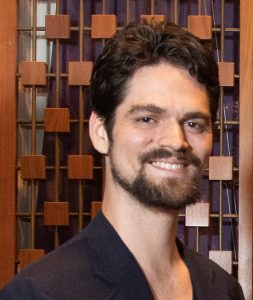 Robert Lopez-Hanshaw is the Music Director at Temple Emanu-El in Tucson, Arizona, and Guest Composer in Residence with the Southern Arizona Symphony Orchestra. He is also the editor of “Practical Microtones”, a compendium of fingerings and playing techniques in 72tet for all standard orchestral instruments, to be published in early 2021. Lopez-Hanshaw is a clinician on the pedagogy of microtones and of the Ashkenazi Jewish prayer modes, at events such as the North American Jewish Choral Festival, the BEYOND Microtonal Music Festival, the Guild of Temple Musicians and the North American Saxophone Alliance Biennial Conference. His pieces have been commissioned by community and religious organisations in Southern Arizona, as well as individual performers throughout the US. His piece “vokas animo”, for choir and full orchestra in 72-tone equal temperament, was premiered in January 2020 by the Tucson Symphony Orchestra and Chorus. Email: robert.a.hanshaw@gmail.com
Robert Lopez-Hanshaw is the Music Director at Temple Emanu-El in Tucson, Arizona, and Guest Composer in Residence with the Southern Arizona Symphony Orchestra. He is also the editor of “Practical Microtones”, a compendium of fingerings and playing techniques in 72tet for all standard orchestral instruments, to be published in early 2021. Lopez-Hanshaw is a clinician on the pedagogy of microtones and of the Ashkenazi Jewish prayer modes, at events such as the North American Jewish Choral Festival, the BEYOND Microtonal Music Festival, the Guild of Temple Musicians and the North American Saxophone Alliance Biennial Conference. His pieces have been commissioned by community and religious organisations in Southern Arizona, as well as individual performers throughout the US. His piece “vokas animo”, for choir and full orchestra in 72-tone equal temperament, was premiered in January 2020 by the Tucson Symphony Orchestra and Chorus. Email: robert.a.hanshaw@gmail.com
Edited by Luke Martin, UK


I like this article very much!